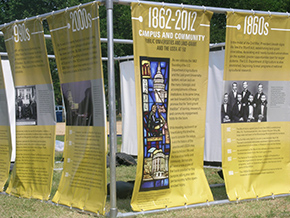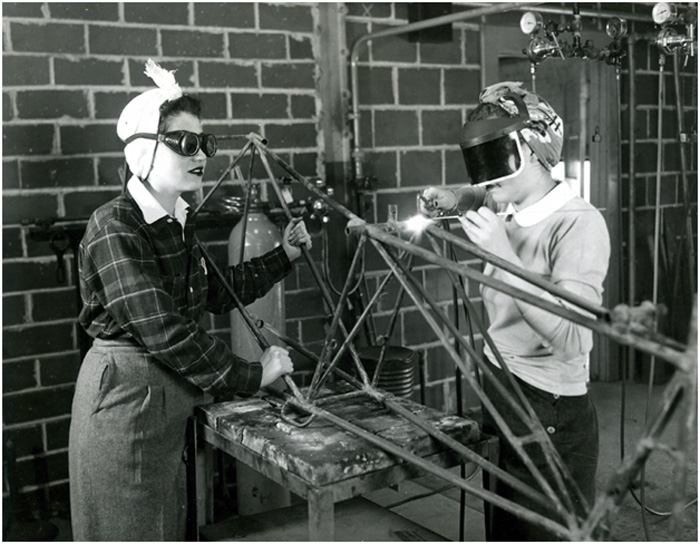Time Travel: Producing the Campus and Community Timeline

The Campus and Community program features a detailed and instructive timeline of events related to the history of public and land-grant universities and the USDA. This installation of graphic panels is located by the Reunion Hall tent. A team of interns conducted the research and compiled the content. Two of them, Shannon Carney (a student at Kent State University) and Mary Ellen Dingley (a recent graduate of George Washington University) share their reflections on this experience.
Shannon Carney explains:
This past spring during my internship, I helped with the preparation for the Campus and Community Folklife Festival program. Along with two fellow interns, I was tasked with creating a timeline of events from 1862 to present. My supervisor, the fearless curator of Campus and Community, Betty Belanus, explained that the timeline should link land-grant university history to American history, showing how they have affected each other. There would be sixteen panels, one for each decade since 1860, and an introduction panel.
This project was daunting because a lot has happened over the last 150 years. As a history major, I know that brevity in historical writing is not easily attained. And for our timeline, each decade would have to be summarized in fifty words, with a few bullet points and pictures.
In any case, we began creating the mock-ups for each panel. I struggled with writing the briefs at first, because I felt that if I left some events out, the story we were telling would lose its meaning. However, through teamwork we were able to create concise, informative briefs.
Over the course of this process, I became extremely invested in many of the stories. One story in particular was that of Iowa State’s first African American football player, Jack Trice. Trice, who had been discriminated against by others in his sport, was mortally wounded during his first game. After reading about Trice I actually cried; but his was not the only touching story. I was also moved and inspired by stories of the all-Japanese American regiment from the University of Hawai`i that fought valiantly in World War II and by Montana State’s feminist protestors in the 1930s. The experiences of these students made me realize that the Campus and Community Festival program is paying tribute to an important part of American history. This program highlights the educational and cultural achievements of land-grant universities. Most importantly, it illuminates the forgotten stories of students whose passion for service, innovation, and improvement embodies the land-grant mission.
-----------------------------------Mary Ellen Dingley adds:

Researching the timeline was an immense assignment – I sometimes became lost for hours, meandering down the trails of history, searching after one individual’s story, trying to verify some facts, or chasing after the perfect photograph. We revised, edited, added to, cut from and carefully contemplated each decade. The timeline became, to me, almost a living project. There were the problem children (what in the world happened in the 1870s?) and the golden children (the 1940s were chock full of events!) and always, the intriguing stories and exciting characters. The University of West Virginia’s first graduate had the fantastic name of Marmaduke Dent, and a fantastic beard to go with it. The students at the University of Illinois boycotted local restaurants in 1946 until they forced them to end their practices of racial discrimination. Who knew?
It’s amazing to see these hours of research transformed into a tangible product. We watched as the design team created miniatures of the huge timeline banners that are now on display on the festival site. The timeline research was at times frustrating and always interesting (as well as a useful review of United States history!). The banners provide visitors a smooth introduction to the land-grant universities, but to me, knowing the weeks of work behind the glossy photos and facts, they also give a bit of well-earned pride.

